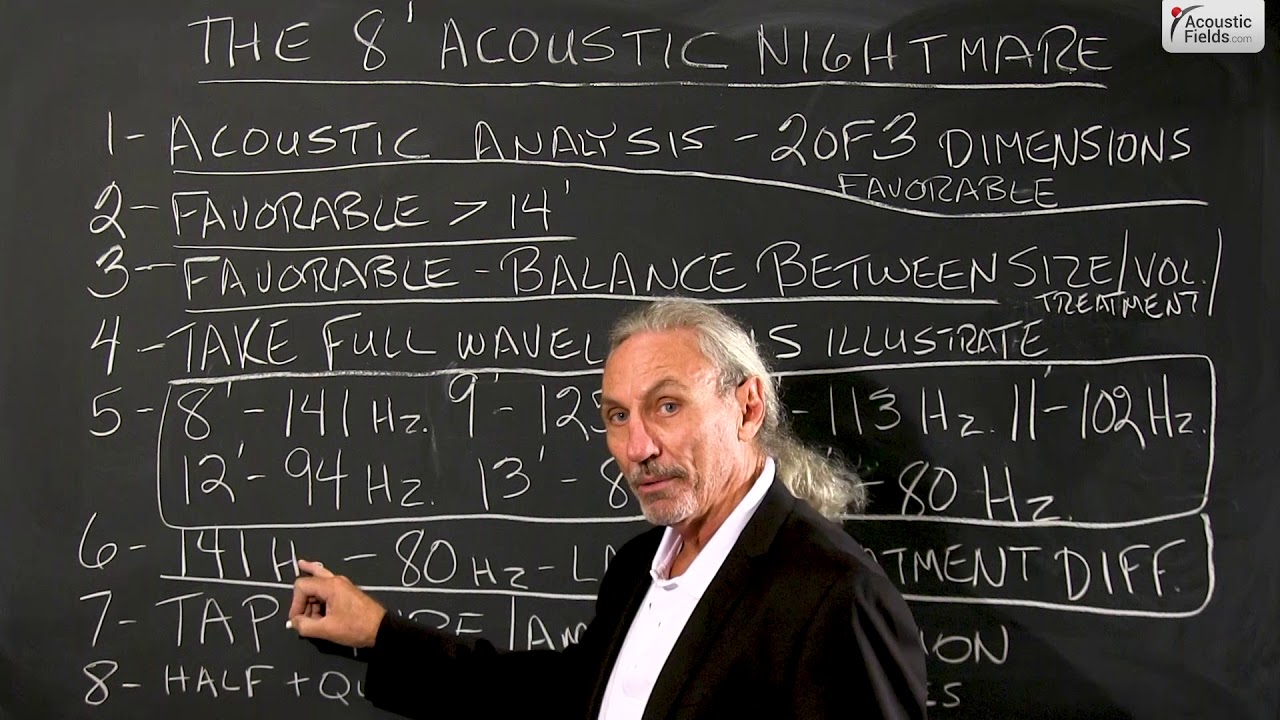Today we’re going to talk about what I call the 8 foot acoustic nightmare. Unfortunately in North America our ceiling heights are mostly in the 8-foot range. And that couldn’t be worse for us in terms of acoustics. Now, like if it’s a drop ceiling height and there’s another foot or two behind that space, that’s good. But most of the time, in North America at least, we have that 8-foot ceiling height that we have to work with.
So when we do acoustic analysis, when I look at all these room forms I try to get at least two of the three, the height, width and the length, favorable. So at least two of the dimensions favorable and about 90% of the time the 8-foot ceiling height is always our nemesis. We can get decent width most of the time, we can get decent length but that 8-foot ceiling height and it runs the whole length and width of the room, see? So any pressure that doesn’t fit in that 8-foot distance is a problem throughout the room.
What’s favorable? 14 foot for width and the length and the height. Now, we would never get that in North America. I do a lot of work in Europe and we most of the time in Europe have larger distances to work with when it comes to ceiling height. But we build new rooms, 14 foot is our minimum ceiling height. And there’s all kinds of reasons for that and let’s talk about one of them.
So we want to get a favorable balance between the size of the room, the volume of the room and the treatment depending on usage. So let’s use full wavelengths for our example so we can just get a feel for it. I know there’s half wavelength and there’s quarter wavelength rules out there but I’m not a big fan of using those to illustrate this particular point.
So let’s use full wavelengths and let’s look at some frequencies and some dimensions. At 8 foot we have a 141 cycles. So everything below 141 is going to be a problem. At 9 foot, look at the change: 141 to 125. At 10 foot, down to 113. At 11 foot, down to 102. 12 foot, 94. 13 foot, 87. And 14 foot, we’re down to the 80 cycle range.
Now, what does this mean? Well, it just means that everything below these numbers must be treated. Okay? And our range is 141 to 80 cycles. So there’s a large treatment difference between a 141 cycle problem and an 80 cycle problem. So the more distance we can give ourselves, the less material we’re going to use, the less amount of material we’re going to use and the less space we’re going to take up in the room. So the higher the ceiling the better.
So another issue with the lower ceilings is then we get in the middle and high frequency reflections which we’ll deal with in another video. So you always want distance in your room to manage all the issues whether they’re pressure issues like we have with the 8 foot or they’re reflection issues with everything above a 141 cycles or below it for that matter.
—
This is an unedited transcript from our video series from Acoustic Fields. There will be some errors in grammar and sentence structure that occur during this translation process.
For complete understanding and comprehension, please view the video which is included in this text. For any additional information regarding this topic or others relating to room acoustics, please contact us directly at:
P: 520 – 392 – 9486







